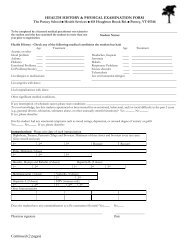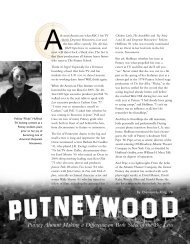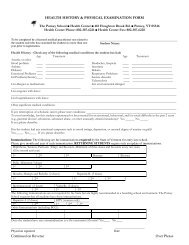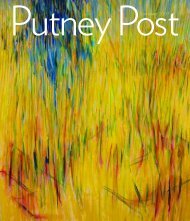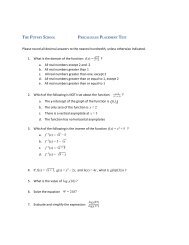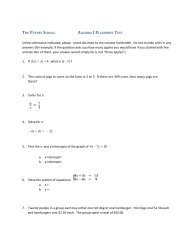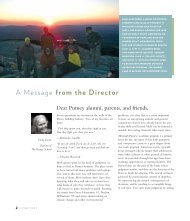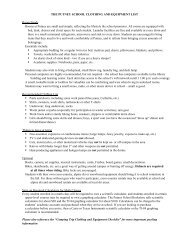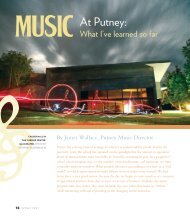26 PUTNEY POST - The Putney School
26 PUTNEY POST - The Putney School
26 PUTNEY POST - The Putney School
You also want an ePaper? Increase the reach of your titles
YUMPU automatically turns print PDFs into web optimized ePapers that Google loves.
<strong>26</strong> <strong>PUTNEY</strong> <strong>POST</strong>
“<br />
charles knowles<br />
Enduring Prints a Half Century On<br />
By Brian Cohen<br />
At <strong>Putney</strong>, Charles’ talent for art found full<br />
expression. <strong>The</strong>se three years were joyous years,<br />
the best of his life. . . . there were so many wonderful<br />
plans! At least eight books were lined up . . .<br />
—Virginia Wendt, Charles Knowles’ mother<br />
”<br />
<strong>PUTNEY</strong> <strong>POST</strong> 27
Senior<br />
Exhibitions<br />
<strong>Putney</strong> has since made<br />
room in its program<br />
for ambitious senior<br />
undertakings. Senior<br />
Exhibitions are an<br />
opportunity for seniors<br />
to design and complete a<br />
two-month independent<br />
project, drawing upon the<br />
breadth of their educational<br />
experience at <strong>Putney</strong> and<br />
bringing together skills and<br />
experience from a variety<br />
of disciplines. Senior<br />
Exhibitions encourage<br />
students to show mastery<br />
through independent<br />
learning across the<br />
curriculum. A key<br />
component of the Exhibition<br />
is a final presentation to the<br />
school community at the end<br />
of the semester in which<br />
an outside evaluator,<br />
a practitioner in the field of<br />
the exhibition, reviews the<br />
student’s accomplishment<br />
with faculty sponsors.<br />
As a 17-year-old <strong>Putney</strong> senior, Charles<br />
Knowles, who had never before cut a<br />
woodblock, was the artist, designer, and<br />
printer of <strong>The</strong> Psalm Book, a folio of nine<br />
large woodblocks of his favorite Biblical<br />
psalms. Fifty years later <strong>The</strong> Psalm Book<br />
remains an extraordinary achievement<br />
among 20th Century artists’ books.<br />
Charlie, as he was known, was born<br />
on August 4, 1939 in Denver, CO. From<br />
an early age he suffered from chronic<br />
degenerative disease of the kidneys and<br />
was not expected to live past childhood.<br />
Between the ages of three and six Charlie<br />
was almost continually in the Children’s<br />
Hospital in Denver. Ill health left him<br />
socially isolated, and he further suffered<br />
from hearing loss. Drawn to art, he<br />
discovered <strong>Putney</strong> and entered tenth<br />
grade in the fall of 1954.<br />
At <strong>Putney</strong>, Charlie found a second<br />
home and close friends. In <strong>The</strong> Type<br />
of Person That I Want to Be, an essay<br />
he composed within weeks of arriving<br />
at <strong>Putney</strong>, Charlie wrote “<strong>Putney</strong>’s<br />
curriculum does not include only English<br />
and Geometry, it has another lesson that<br />
public school can never teach—how<br />
to live with others, and consequently<br />
yourself . . .” He loved Friday Night Sing<br />
and Sunday Evening Meeting, became<br />
immersed in music and art, and sought<br />
at <strong>Putney</strong> “a beautiful life full of happiness<br />
for myself and others.” A close friend from<br />
<strong>Putney</strong>, the artist Jon Hendricks, recalls<br />
redesigning the literary magazine<br />
with Charlie. Charlie was “a misfit,<br />
awkward, gangly, but wonderful—<br />
with an independent mind.”<br />
Charlie’s achievements at <strong>Putney</strong> were<br />
all his own, but he was helped along by<br />
two key <strong>Putney</strong> figures of the 1950’s. Both<br />
Jerry Pfohl, who taught art from 1956 to<br />
1959, and Bob Treat, who taught history<br />
and was director of admissions from<br />
1955 to 1964, supported Charlie in his<br />
ambitious, if not somewhat presumptuous<br />
senior project. Charlie had been a clumsy<br />
and not always motivated student. Jerry<br />
Pfohl, a painter who now lives in Acworth,<br />
NH, recalls kicking Charlie out of his evening<br />
activity for clowning around. Offered<br />
the possibility to return to class when he<br />
got serious, Charlie said he wanted to<br />
create a book on the Biblical psalms that<br />
meant the most to him, and he came back<br />
to class, settled down, and got to work.<br />
When he did get serious, he worked like<br />
crazy. Charlie had worked as a printer’s<br />
devil (assistant) at the Register-Call in<br />
Central City, CO in the summers of 1955<br />
and 1956, so he knew his way around a<br />
print shop. Between his own persistence<br />
and Bob Treat’s more diplomatic intervention,<br />
Charlie got permission to work<br />
at Brattleboro Printing Company, located<br />
down an alley on Elliott Street. Jerry Pfohl<br />
drove Charlie to town several times a<br />
week to work on the book. Charlie showed<br />
Jerry how to set type on a composing<br />
stick, and Jerry helped Charlie distribute<br />
his type (put it back in the case). At one<br />
point Jerry looked at Charlie’s messy,<br />
ink-smudged printed sheets coming off the<br />
large Washington hand press and asked<br />
him if that was how he really wanted his<br />
finished pages to look. Charlie responded<br />
that he thought it showed “character.”<br />
Jerry questioned that assertion, and taught<br />
him how to print without fingerprints.<br />
Charlie worked 12 to 14 hours a day into<br />
Project Week on <strong>The</strong> Psalm Book, going<br />
“full throttle.” According to Jerry, Charlie<br />
was aware that he didn’t have a lot of<br />
time to complete his work. In the spring<br />
of his senior year, as he was finishing<br />
the book, Charlie wrote in a 35-page<br />
essay called <strong>The</strong> Hand Turneth: A Study<br />
in Creativity, “Death is an overseer. It<br />
holds the whip hand that drives men to<br />
creation.” He quoted Ecclesiastes 9:10,<br />
“Whatsoever thy hand findeth to do, do it<br />
with all thy might; for there is no work, nor<br />
device, nor knowledge, nor wisdom, in<br />
the grave, whither thou goest.” Jerry Pfohl,<br />
28 <strong>PUTNEY</strong> <strong>POST</strong>
Charlie off to Brattleboro Memorial<br />
Hospital. Charlie turned to him and calmly<br />
said, “It’s OK. I’m not dead yet.”<br />
<strong>The</strong> Psalm Book was completed by<br />
the end of Project Week in June of 1957.<br />
Charlie presented the completed prints<br />
to Bob Treat, who had been so helpful in<br />
getting the book underway. Charlie let<br />
Bob pick out the first set of prints, and<br />
asked him for only $10 for the entire book.<br />
Bob said, “I can’t just give you $10. How<br />
about $20?” Shortly before his death, Bob,<br />
who died in early June of this year after an<br />
extraordinary career as an educator and<br />
community activist, and his wife, Mary Lou,<br />
let <strong>Putney</strong> know that they were leaving a<br />
rare gift to the school: the original art work<br />
from <strong>The</strong> Psalm Book.<br />
who admits to some frustration with some<br />
of Charlie’s more exasperating character<br />
traits, recalls the concern of director Ben<br />
Rockwell that Charlie was working too<br />
hard. Pfohl remembers Rockwell coming<br />
to the door of his apartment in spring of<br />
1957 telling him that Charlie’s illness was<br />
terminal, a fact known only to Rockwell<br />
and Charlie at that point. Later, while<br />
trimming a piece of wood spacing at the<br />
print shop, Charlie cut himself rather<br />
badly. Jerry panicked and, shaking badly,<br />
backed into another car while driving<br />
Despite his worsening illness and the<br />
self-imposed, almost compulsive pressures<br />
of completing <strong>The</strong> Psalm Book,<br />
Charlie found time to pass his academic<br />
classes and apply to college, and<br />
was accepted at Brown University. His<br />
freshman year roommate was Gregory<br />
Floyd who, by coincidence, was head<br />
consultant to the search committee for<br />
a new <strong>Putney</strong> director in 2006. Gregory<br />
recalls, “Charlie was shy, a bit gawky,<br />
with a quick smile and a very engaging<br />
manner. We swapped boarding school<br />
stories. This was my first awareness of<br />
<strong>Putney</strong>.” He recalls Charlie showing him<br />
<strong>The</strong> Psalm Book and remembers Charlie’s<br />
depiction of beautiful harps and weeping<br />
willows printed in vibrant colors (Psalm<br />
137). “Charlie told me of trekking through<br />
winter snow to print his graphics at a local<br />
press (a bit of an exaggeration, as Jerry<br />
Pfohl drove him to town in his car). He<br />
was a splendid young man—brimming<br />
with talent, quiet, calm and confident—a<br />
nice addition to my life . . . . . for a time.”<br />
Charlie became too sick to complete<br />
the year at Brown, and died in March<br />
of 1958 at the age of 18.<br />
<strong>PUTNEY</strong> <strong>POST</strong> 29
FORMER <strong>PUTNEY</strong> TEACHERS<br />
MARY LOU AND BOB TREAT<br />
STAND IN FRONT OF ONE<br />
OF CHARLES KNOWLES ’57’S<br />
PRINTS, WHICH THEY’VE<br />
GIVEN TO THE SCHOOL.<br />
Ten copies of <strong>The</strong> Psalm Book were printed.<br />
One remains in the collection of the<br />
Houghton Library at Harvard University.<br />
<strong>The</strong> book was featured in a major 1961<br />
exhibition <strong>The</strong> Artist & <strong>The</strong> Book 1860–1960<br />
at the Museum of Fine Arts in Boston,<br />
by far the most significant exhibition<br />
of illustrated books in the United States<br />
to that date.<br />
I first saw framed pages from <strong>The</strong> Psalm<br />
Book hanging in the Library Building when<br />
I came to <strong>Putney</strong> in 1985. I was struck by<br />
the size (each of the eighteen sheets is<br />
<strong>26</strong>" x 19 5 /8"—the book is nearly 40" wide<br />
when open), by the simple power of the<br />
pages, and by their unaffected evocation<br />
of the meaning of the text. Each page<br />
touches a distinct emotional note. Charlie<br />
chose authoritative wood display type for<br />
the numerals heading each sheet, and<br />
printed the text of the poems in a solid,<br />
workmanlike nineteenth century typeface.<br />
He printed on colored paper, and mixed<br />
his own colored inks. <strong>The</strong> woodblocks are<br />
forcefully carved, possessing a penetrating<br />
grace. My own favorite, Psalm 142, depicts<br />
a lean figure printed in white on dark blue<br />
paper, enclosed by black dolmen (here<br />
he allows the grain of the wood to show,<br />
looking almost like stone). It is a moving<br />
image of despair and entreaty, longing,<br />
and faith.<br />
For more information:<br />
<strong>The</strong> Psalm Book of Charles Knowles,<br />
introduction by Philip Hofer, foreword<br />
by Katherine Kuh, New York: <strong>The</strong> Viking<br />
Press, 1962<br />
<strong>The</strong> Artist & <strong>The</strong> Book 1860–1960 in<br />
Western Europe and the United States,<br />
Boston: Museum of Fine Arts, 1961<br />
Copies of <strong>The</strong> Psalm Book are in the<br />
collections of the Houghton Library at<br />
Harvard, <strong>The</strong> Museum of Modern Art<br />
in New York City, the Israel National<br />
Museum, and the National Gallery<br />
in Washington.<br />
http://web.sfts.edu/<br />
Brian D. Cohen has taught art at<br />
<strong>Putney</strong> since 1985, and is currently Dean<br />
of Faculty. A printmaker and book artist,<br />
his work is held by numerous public and<br />
private collections throughout the country.<br />
30 <strong>PUTNEY</strong> <strong>POST</strong>




